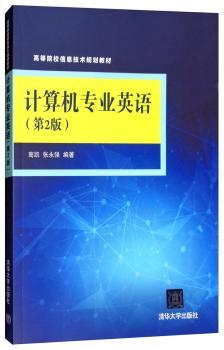内容简介
《计算机专业英语(第2版)》C#、Java以及Android移动开台、分布式系统、网络信息检索与搜索引擎技术、开源信息检索工具、人工智能、绿色计算、云计算、无线传感网、物联网、虚拟化技术、统一通信、下一代网络服务技术、ACM图灵奖科学家事迹简介、IT职业规划等新IT科技及相关内容,选材广泛,内容丰富,配有单词注解、难句翻译、相关专业知识说明、背景知识介绍等。 读者在学算机专业英语(第2版)》的同时,还可以了解科技英语中常用的语法,掌握常用的计算机专业英语词汇和表达方式,提高计算机专业知识的阅读和理解能力。 《计算机专业英语(第2版)》选材新颖、图文并茂,具有系统、、技术前瞻,适合作为高等院校学生和专业技术人员学机专业英语的教材及工具书,并可作为信息技术领域的技术人员和管理人员的参考用书。
目录
Chapter 1 Programming and Mobile Development PlatformSection 1 C# and the .NET frameworkSection 2 Java OverviewSection 3 Android PlatformBackground KnowledgeThi and ExercisingReferenceSome Translationr/>Chapter 2 Introduction on Distributed SystemSection 1 Definition of a Distributed SystemSection 2 Distributed System Goal I: M Resources AcceleSection 3 Distributed System Goal II: M Distribution TransparencySection 4 Distributed System Goal III: Openner/>Section 5 Distributed System Goal IV: ScalabilityBackground KnowledgeThi and ExercisingReferenceSome Translationr/>Chapter 3 Web SearchSection 1 Background and HistorySection 2 Web Characteristicr/>Section 3 Advertising as the Economic ModelSection 4 The Search User ExperimenceSection 5 Intellectualized Techniques in Search EngineBackground KnowledgeThi and ExercisingReferenceSome Translationr/>Chapter 4 Introduction on Information Retrieval Toolr/>Section 1 Evolution of Information Organization and Accer/>Section 2 Understanding LuceneSection 3 Indexing and searchingSection 4 Nutch——Case study based on LuceneSection 5 Introduction on ElasticsearchBackground KnowledgeThi and ExercisingReferenceSome Translationr/>Chapter 5 Introduction on Artificial IntelligenceSection 1 What is AI?Section 2 The History of Artificial Intelligence (Part 1)Section 3 The History of Artificial Intelligence (Part II)Section 4 The State of the ArtBackground KnowledgeThi and ExercisingReferenceSome Translationr/>Chapter 6 Green ComputingSection 1 Approaches to Green ComputingSection 2 Future of Green ComputingSection 3 Ways of implementationSection 4 Green IT: The next burning issue for businer/>Section 5 ConclusionBackground KnowledgeThi and ExercisingReferenceSome Translationr/>Chapter 7 Cloud ComputingSection 1 IntroductionSection 2 Why Cloud Computing?Section 3 Benefits of Cloud ComputingSection 4 Cloud Computing Drawbackr/>Section 5 Cloud Computing Technologier/>Background KnowledgeThi and ExercisingReferenceSome Translationr/>Chapter 8 Wireless Sensor Networkr/>Section 1 Sensor Network Applicationr/>Section 2 Embed Network TechnologySection 3 Systems ChallengeSection 4 Self-Organized Networkr/>Section 5 Conserving Power and BandwidthSection 6 Privacy and ConclusionBackground KnowledgeThi and ExercisingReferenceSome Translationr/>Chapter 9 The Inter of Thingr/>Section 1 What is the Inter of Thingr/>Section 2 Technologies for the Inter of Thingr/>Section 3 Market Opportunitier/>Section 4 Challenges and Concernr/>Section 5 Implications for the Developing WorldSection 6 2020: A Day in the LifeSection 7 A New EcosystemBackground KnowledgeThi and ExercisingReferenceSome Translationr/>Chapter 10 VirtualizationSection 1 IntroductionSection 2 Common TerminologySection 3 Companies Using VirtualizationSection 4 Why Virtualized Technology?Section 5 Benefits of VirtualizationBackground KnowledgeThi and ExercisingReferenceSome Translationr/>Chapter 11 Unified Communicationr/>Section 1 IntroductionSection 2 Enter Unified Communicationr/>Section 3 The Real-Time Communications DaoardSection 4 Communications Enabled Business Procer/>Section 5 Enterprise Business Case for Unified Communicationr/>Section 6 Just In Time Fetch The ExpertSection 7 Challenges and ConclusionBackground KnowledgeThi and ExercisingReferenceSome Translationr/>Chapter 12 Next Generation Network Servicer/>Section 1 NGN Value Proposition for Service Providerr/>Section 2 Next Generation Servicer/>Section 3 Next Generation Service ArchitectureSection 4 Conclusionr/>Background KnowledgeThi and ExercisingReferenceSome Translationr/>Chapter 13 Introduction on the ACM Turing AwardSection 1 about TuringSection 2 about ACMSection 3 Turing Award and Some Award Scientistr/>Section 4 Turing Award Recipients and Citationr/>Background KnowledgeThi and ExercisingReferenceSome Translationr/>Chapter 14 IT Careers PlanningSection 1 Personal GrowthSection 2 "You've got to find what you love,"Jobs sayr/>Section 3 Bill Gates Speaks with Young Leaders on "Leadership, Responility and Innovation"Section 4 IT Workers Improve Your Writing Skillr/>Section 5 The 10 Worst Mistakes Career Changers MakeBackground KnowledgeThi and ExercisingReferenceSome Translationr/>Words
摘要与插图
Programming and Mobile
;Development Platform。
;;In this chapter,we will present the coding knowledge and the popular mobile develop—ment platform.C#and the.NET framework will be present first.then the comparabilityOamong C#and Visual Basic ;NET,Java,C++will be proposed Java overview,includingits history,its class libraries,its typical environment,will be present then.Android is a newopen source software toolkit for mobile phones that was created by Google and theopen handest allianceears,it's expected to be found in millions of cellphones and other mobile devices,m Android a n~jor platform for application developers.
;;;;Section 1 ;and the.NET framework
;;The goal of c#is to provide a simple,safe,modem,object-oriented,Inter-centric,high performance language for.NET development C#is a new language.but it draws onthe lessons learned over the past three decades In much the way that you can see in youngchildren the features and personalities of their parents and grandparents,you can easily see inC#the influence of Java.C++.Visual Basic.and other languages
;;The focus of this section is the C#language and its use as a tool for programming on the.NET platform.You learn C#specifically to create NET applications This section does notconsider C#in a vacuum but places the language firmly in the context of Microsoft’s NETplatform and in the development of desktop and Intemet applications.
;;pan style="font-family:宋体">.Overview of.NET
;;When Microsoft announced C#in July 2000.its unveilingO was part of a much larger
.........



